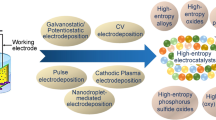Abstract
Variations in the current in the [Fe(CN)6]3−/[Fe(CN)6]4− system flowing through a vertical microorifice in the insulating film on the electrode are shown. Steady- and nonsteady-state conditions of electrolysis are studied for different insulating film thicknesses. The obtained results suggest that at steady-state electrolysis, in an insulator channel, near the electrode, a “stagnant zone” is formed in which the natural convection of electrolyte is weak. Mass transfer in this zone preferentially occurs due to the reagent diffusion. The length of this zone increases with the increase in the channel length. A zone with the natural convection of electrolyte is located at a certain distance from the electrode, closer to the insulator surface. A part of this zone is located in the solution bulk and its thickness is independent of the channel length. The mass transfer in this zone is realized by both the reagent diffusion and the natural convection of electrolyte. Voltammetric measurements show that at sufficiently high potential scanning rates, the peak currents on a planar electrode and on an electrode placed on the bottom of the channel in the insulating film virtually coincide. This result points to the possibility of using potentiodynamic methods for analyzing the electrolyte composition inside the channel and in the solution bulk irrespective of the thickness of the electrode-insulating film.
Similar content being viewed by others
References
Mehdizadeh, S., Dukovic, J.O., Andricacos, P.S., Romankiw, L.T., and Cheh, H.Y., J. Electrochem. Soc., 1992, vol. 139, p. 78.
Andricacos, P.S., Uzoh, C., Dukovic, J.O., Horkans, J., and Deligianni, H., IBM J. Res. Dev., 1998, vol. 42, p. 567.
Maner, A., Harsch, S., and Ehrfeld, W., Plat. Surf. Finish., 1988, vol. 75, no. 3, p. 60.
Ehrfeld, W. and Lehr, L., Radiat. Phys. Chem., 1995, vol. 45, no. 3, p. 349.
Landolt, D., Electrochem J. Soc, 2002, vol. 149, p. 9.
Nilson, R.H. and Griffiths, S.K., J. Electrochem. Soc., 2003, vol. 150, p. 401.
Higdon, J.J.L., J. Fluid Mech., 1985, vol. 159, p. 195.
Laitinen, H.A. and Kolthoff, I.M., J. Am. Chem. Soc., 1939, vol. 61, p. 3344.
West, A.C. and Newman, J., J. Electrochem. Soc., 1991, vol. 138, p. 1620.
Diem, C.B., Newman, B., and Orazem, M.E., J. Electrochem. Soc., 1991, vol. 138, p. 2947.
Dinan, T.E., Matlosz, M., and Landolt, D., J. Electrochem. Soc., 1991, vol. 138, p. 2947.
Roy, S., Gupte, Y., and Green, T.A., Chem. Eng. Sci., 2001, vol. 56, p. 5025.
Georgiadou, M., Mohr, R., and Alcire, R., J. Electrochem. Soc., 2000, vol. 147, p. 3021.
Griffiths, S.K. and Nilson, R.H., Microsystem Technologies, 2002, vol. 8, p. 335.
Desilvestro, J. and Haas, O., Electrochim. Acta, 1991, vol. 36, p. 361.
Stevens, N.P.C., Rooney, M.B., Bond, A.M., and Feldberg, S.W., J. Phys. Chem., 2001, vol. A105, p. 9085.
Grigin, A.P. and Davydov, A.D., Elektrokhimiya, 1998, vol. 34, p. 1111 [Russ. J. Electrochem. (Engl. Transl.), vol. 34, p. ].
Duchanoy, C., Lapicque, F., Oduoza, C.F., and Wragg, A.A., Electrochim. Acta, 2000, vol. 46, p. 433.
Volgin, V.M. and Davydov, A.D., Elektrokhimiya, 2006, vol. 42, p. 567 [Russ. J. Electrochem. (Engl. Transl.), vol. 42, p. ].
Wragg, A.A. and Krysa, J., J. Appl. Electrochem., 2007, vol. 37, p. 33.
Randles, J.E.B., Trans. Faraday Soc., 1948, vol. 44, p. 327.
Author information
Authors and Affiliations
Corresponding author
Additional information
Original Russian Text © A.G. Zelinskii, 2010, published in Elektrokhimiya, 2010, Vol. 46, No. 4, pp. 454–461.
Rights and permissions
About this article
Cite this article
Zelinskii, A.G. Peculiarities of mass transfer and natural convection in the redox system [Fe(CN)6]3−/[Fe(CN)6]4− with current flowing through a microorifice in insulating coating on the electrode. Russ J Electrochem 46, 431–437 (2010). https://doi.org/10.1134/S1023193510040087
Received:
Published:
Issue Date:
DOI: https://doi.org/10.1134/S1023193510040087




